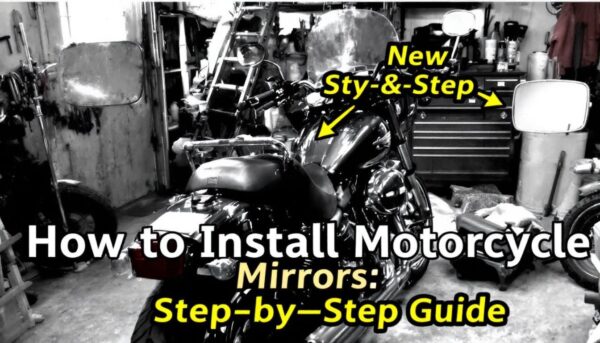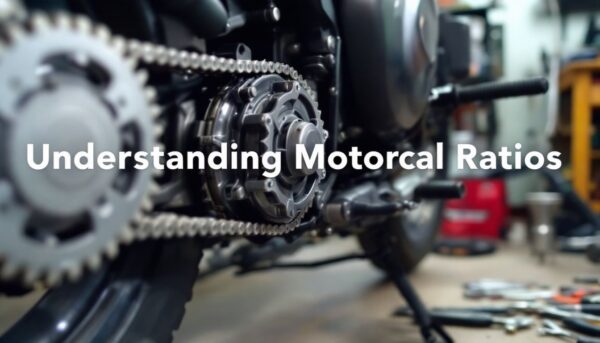
Motorcycle Carburetor Issues: Common Problems and Fixes
You might be facing trouble with your motorcycle’s engine. It could be acting up because of carburetor issues. A common sign is strange sounds or having a hard time starting the bike.
One key fact to note is that clogged pilot jets often mess with how well your bike runs.
This article will guide you through fixing and understanding motorcycle carburetor problems. You’ll learn about cleaning, adjusting, and what signs to watch for. Keep reading to sort out those carbie troubles!
Key Takeaways
- Clean your carburetor regularly to keep your bike running well. Use cleaner, rags, and brushes for this job.
- Adjust the fuel mixture if your bike is not running smoothly. Turn the mixture screw 1-2 turns out from its closed position as a starting point.
- Replace clogged jets to improve performance. Clogged jets can cause poor acceleration and rough idling.
- High-quality fuel helps avoid motorcycle engine problems. It keeps the engine clean and reduces deposits in the carburettor.
- Store your motorcycle properly during off-seasons. Clean it first, use a stabiliser or drain the fuel, and cover it to protect from dust and moisture.
Understanding Common Carburetor Problems
Common carburetor problems can affect your motorcycle’s performance. You need to know these issues to keep your bike running smoothly.
Too lean or too rich mixture
A bike carburettor needs the right fuel-air mixture to work well. If the mixture is too lean, it means there isn’t enough fuel. This can cause strange sounds like popping or sneezing from your engine.
You might also notice poor acceleration and rough idling. On the other hand, a rich mixture has too much fuel. It can lead to black smoke from the exhaust and bad fuel efficiency.
Clogged pilot jets are often a common problem with carburettors that affect this balance. Regular maintenance helps keep these jets clear so you avoid a dirty carburettor’s symptoms like difficulty starting or stalling while riding.
The mixture screw plays an important role in getting this balance just right for smooth performance.
Fixing issues with too lean or too rich mixtures will improve your motorcycle’s overall health. Next, let’s look at how to identify signs of carburettor trouble.
Out of adjustment
An out-of-adjustment carburettor can cause many problems. It affects fuel flow and air mixture. This leads to poor engine performance in your motorcycle. You may hear strange sounds like popping or sneezing if it is not set correctly.
These noises often indicate a failing carburettor.
When the mixture screw or pilot jet is out of line, you might have trouble starting your bike. Rough idling and poor acceleration are also common signs of issues with the carburettor.
If you notice these symptoms, it is time to check the settings on your bike’s fuel system.
Regularly adjusting your motorbike’s carburettor can prevent future problems. Make sure to adjust it as needed for optimal performance. Doing this will help keep your motorcycle running smoothly and efficiently, saving you from costly repairs later on.
Clogged jetsClogged jets are common in motorcycle carburetors. This problem often affects older bikes or those that have been parked for a while. When the pilot jets block, your bike may struggle to idle properly and show poor performance.
You might notice difficulty starting, rough idling, and bad acceleration.
Cleaning clogged jets can help restore your bike’s power. Regular maintenance is key to avoiding dirt buildup. Take care of your carburetor with regular checks and cleaning to keep it running well.
Diagnosing motorbike carburettor problems early will save you time and money down the road.
Common Signs of Carburetor Issues
Your motorcycle may show signs of carburetor problems. You might hear strange sounds or find it hard to start your bike.
Strange sounds
Strange sounds can be a sign of motorcycle carburettor issues. You might hear popping, banging, or sneezing noises from the engine. These sounds often mean that the carburettor is failing.
Blocked carburettors are common, especially in older bikes or those that have sat for a long time.
Look out for symptoms like difficulty starting and rough idling. Clogged pilot jets are one of the most frequent problems with carburettors. They impact your bike’s performance and idle quality.
Ignoring these sounds may lead to more serious problems down the road.
Pay attention to how your motorcycle runs. Signs of a bad carburettor include decreased fuel efficiency and engine stalling. Early diagnosis can save you time and money on repairs later on.
Always troubleshoot issues as they arise to keep your ride smooth and enjoyable.
Difficulty starting
Strange sounds can lead to another issue: difficulty starting your motorcycle. A dirty carburetor often causes this problem. Symptoms include rough idling and poor acceleration. If your bike struggles to start, check the carburetor first.
Clogged pilot jets are a common problem with carburetors. They impact how well your motorcycle runs at idle. Cleaning these jets will help improve performance and make starting easier.
Regular maintenance keeps the fuel system in top shape.
Using high-quality fuel also helps prevent starting issues. Low-quality fuel can lead to gunk build-up in the carburettor, making it hard for your bike to fire up. Keep an eye on these factors for smooth starts and better rides ahead!
Poor performance
Poor performance in your motorcycle can be linked to carburetor issues. Symptoms include difficulty starting, rough idling, and poor acceleration. A clogged pilot jet is often the main culprit affecting these problems.
This blockage disrupts how your bike runs and can decrease fuel efficiency too. Strange sounds from the engine may also signal a bad carburetor.
Addressing these issues early will help keep your motorbike running smoothly. Regular cleaning of the carburetor prevents build-up and extends its life. Proper maintenance is key to avoiding common bike carburettor problems and achieving optimal performance on the road.
Idling problems
Idling problems can be a sign of motorcycle carburetor issues. A dirty or clogged carburettor may cause your bike to stall or idle roughly. Symptoms like these often come from blocked pilot jets.
These jets are vital for the idle and performance of your motorbike.
If you notice strange sounds during idling, it could point to trouble with the carburettor. Cleaning your motorcycle carburettor can help fix these issues. Regular maintenance is key to keeping your bike running smoothly and preventing further complications in the future.
Solutions for Carburetor Problems
Cleaning your carburetor can solve many issues. Adjusting the fuel mixture helps your bike run smoothly again.
Cleaning the carburetor
Cleaning your motorcycle carburetor is key to keeping your bike running well. A dirty carburettor can lead to many issues like poor performance and difficulty starting.
- Gather Your Supplies: Get a clean workspace. You will need carburettor cleaner, rags, and small brushes. Use safety goggles and gloves for protection.
- Remove the Carburettor: Start by turning off the fuel supply. Carefully disconnect the throttle cable and any linkages. Remove the carburettor from the engine.
- Disassemble the Carburettor: Take off the float bowl and other parts carefully. Keep track of each piece as you take it apart.
- Inspect for Damage: Look at all parts for wear or damage. Check gaskets, jets, and needles closely.
- Clean with Carburettor Cleaner: Spray carburettor cleaner on all surfaces. Use brushes to scrub away dirt and grime, especially around clogged pilot jets.
- Clear Blocked Jets: Use a thin wire or jet cleaning tool to clear out any clogs in the jets. Clogged pilot jets are very common in bike carburetor problems.
- Soak Parts if Necessary: For tough stains, soak components in carb cleaner for a few hours.
- Rinse and Dry Parts: Rinse every part with clean water after soaking or scrubbing off dirt. Make sure everything is dry before reassembling.
- Reassemble the Carburettor: Put all parts back together in reverse order of disassembly. Ensure that gaskets are replaced if needed.
- Install the Carburettor Again: Attach it back to your motorcycle carefully.
- Adjust Mixture Screw: The mixture screw helps control fuel flow and plays a crucial role in idle performance.
- Test Run Your Bike: Start your motorbike after reassembly to check if it runs smoothly again without strange sounds or idling problems.
Regularly cleaning your motorcycle carburettor improves performance and prevents common issues related to motorcycle fuel systems.
Adjusting the mixture
After cleaning the carburettor, you may need to adjust the mixture. A proper mixture is key for good performance.
- Identify the Mixture Screw
Locate the mixture screw on your carburettor. This screw controls how much fuel mixes with air.
- Check the Current Setting
Take note of the current position of the screw. Count how many turns it takes to close it completely. This will help you return to this setting if needed.
- Start with a Base Setting
Turn the screw 1-2 turns out from its closed position. This gives a starting point for adjustment.
- Test Idle Performance
Start your motorcycle and let it idle. Observing how well it runs can indicate if you need to adjust further.
- Adjust Gradually
Make small adjustments by turning the screw in or out slightly, usually no more than a quarter turn at a time. Listen for changes in engine sounds.
- Look for Symptoms
Watch for signs of too lean or too rich mixtures; these include strange sounds or poor performance during rides.
- Final Testing
After adjusting, take your bike for a test ride. Pay attention to acceleration and idling problems that may still exist.
- Repeat as Needed
If necessary, repeat adjustments until you find the right balance for your motorcycle’s engine fuel system.
- Document Your Changes
Keep track of all settings used during adjustments so you can refer back later if issues arise again.
- Regular Maintenance
Regular adjustments and checks are vital to avoid common carburettor problems later on and ensure smooth operation over time.
These steps can help with diagnosing motorcycle carburettor problems and fixing them effectively while improving overall bike performance.
Replacing clogged jets
Replacing clogged jets helps improve your motorcycle’s performance. Clogged jets often cause poor acceleration and rough idling.
- Start by removing the carburettor from your bike. Make sure you have the necessary tools handy, like screwdrivers and wrenches.
- Detach the bowl from the bottom of the carburettor. This area holds the jets. It may take some effort to loosen screws if they are rusted.
- Locate the pilot jet and main jet inside the carburettor. These components control fuel flow. A clogged jet can cause engine stalling or decreased fuel efficiency.
- Carefully remove each jet with a suitable tool. Take care not to damage them, as replacements can be tricky to find.
- Inspect each jet for blockages or dirt. You might see tiny holes that need cleaning out to restore proper function.
- Use a soft brush or compressed air to clean the jets gently. This will help break up any build-up without damaging them.
- If a jet is too damaged, replace it with a new one from your local motorcycle shop or online store. Stock parts are usually best, especially for stock engines.
- Reinstall both jets into their correct positions in the carburettor after cleaning or replacing them.
- Reattach the bowl back onto the carburettor securely after ensuring all components are in place.
- Finally, reconnect the carburettor to your bike’s intake manifold and adjust any settings needed for optimal performance.
Properly replacing clogged jets will enhance your motorcycle’s fuel system efficiency and fix issues caused by dirty components, setting you up for better rides ahead.Next, focus on preventing these carburetor problems through regular maintenance and care.
Prevention and Maintenance
To keep your carburetor in top shape, regular cleaning is key. Use high-quality fuel to help prevent issues down the line.
Regularly cleaning and maintaining the carburetor
Regular cleaning and maintenance of the carburettor are crucial. These steps help prevent common motorcycle carburettor issues.
- Clean the Carburettor: Use a carburettor cleaner to remove dirt and grime. A clean carbie improves performance and fuel efficiency.
- Check for Clogs: Inspect the jets regularly. Clogged pilot jets affect idle speed and make starting tough.
- Adjust the Mixture Screw: This screw helps regulate air and fuel mix. Proper adjustment ensures smooth running and good acceleration.
- Use Quality Fuel: High-quality fuel keeps your engine clean. It reduces deposits that can clog up the carburettor.
- Store Properly: Keep your bike in a dry place during off-seasons. This prevents rust and other damage to the carburettor.
- Regular Inspections: Look for strange sounds like popping or sneezing from the engine. These noises often signal issues with your bike’s fuel system.
- Keep Idle Smooth: If you notice rough idling, it might be time to clean or adjust your carburettor.
- Follow a Maintenance Schedule: Set reminders for regular cleaning and checks on your motorbike fuel system.
- Watch for Symptoms of Dirty Carburettors: Difficulty starting, rough idling, or poor acceleration can mean it’s time for some TLC on your carbie.
- Learn from Videos: Motorcycle carburettor repair videos offer visual guidance on troubleshooting common problems effectively.
Taking these steps will extend your motorcycle’s longevity while keeping performance high.
Using high quality fuel
Using high-quality fuel is key for your motorcycle’s carburetor. Good fuel helps keep the engine clean and runs smoothly. Poor quality fuels can cause problems like dirt in the carburettor.
This leads to issues such as rough idling, difficulty starting, and poor acceleration.
Old bikes or those left standing often suffer from blocked carburettors. Using dirty or low-grade fuel makes this worse. Always choose a trusted brand of petrol to avoid motorcycle engine fuel system troubles.
The right fuel will help you maintain your bike’s performance and extend the life of the carburettor.
Properly storing your motorcycle during off-seasons
Proper storage keeps your motorcycle in good shape. Clean the bike before putting it away. Dirt and grime can cause damage over time.
Drain the fuel from the tank or use a stabiliser to prevent blockage. Old fuel can create problems later on. Check the carburettor for any signs of clogs during this process. Covering your motorcycle will protect it from dust and moisture too.
Store it in a dry place, ideally indoors, to avoid rust and other issues while not riding your motorbike.
Conclusion
Motorcycle carburetor issues can be a pain. You might hear strange sounds or have trouble starting your bike. Regular cleaning and maintenance can help you avoid these problems. Pay attention to how your motorcycle runs.
Fixing these issues will keep your ride smooth and enjoyable.
FAQs
1. What are common motorbike carburettor problems?
Common motorcycle carburetor issues include blockage symptoms, improper tuning and fuel system issues that affect the engine’s performance.
2. How can I diagnose my bike’s carburettor issues?
Diagnosing motorcycle carburetor problems involves checking for signs of clogging, performing a thorough inspection of the fuel system and making necessary adjustments to rectify any identified issues.
3. Can maintenance help prevent motorcycle carburettor troubles?
Yes, regular motorcycle carburetor maintenance such as cleaning and proper tuning can greatly reduce potential motorbike carburetor problems, ensuring your ride runs smoothly.
4. How do I fix my motorbike’s carbie if it has blockage symptoms?
Fixing motorcycle carburetor with blockage symptoms usually involves cleaning or adjusting the carbie parts to ensure optimal functionality of your bike’s fuel system.
5. What steps should I take in troubleshooting my bike’s fuel system?
Motorcycle engine fuel system troubleshooting includes diagnosing motorcycle carburettor problems, carrying out necessary fixes like cleaning or adjustment and maintaining overall health through regular checks.


